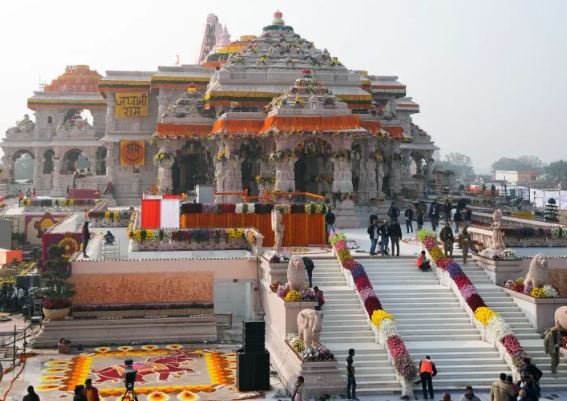Monday’s inauguration of the new Ram Mandir in Ayodhya by India’s prime minister, Narendra Modi, was a moment decades in the making. Yet it also came too early. Despite the grand spectacle of the ceremony, with celebrities, tycoons and politicians in attendance, the temple is still incomplete. There is an obvious explanation for this rushed endeavour, and it is not religious. India will go to the polls in late spring and while Mr Modi is all but guaranteed to win a third term, he wants a large majority for his Bharatiya Janata party (BJP).
Mr Modi rode to power, and has entrenched it, on the back of rightwing Hindu nationalism. On Monday he went beyond the exploitation of ethno-religious sentiment. He did not merely attend the ceremony; he carried out rituals. Religion and authoritarianism have proceeded hand-in-hand in recent years. But few strongmen have melded the political and religious to quite this degree. As his biographer, Nilanjan Mukhopadhyay, observed, the event cast him as “the high priest of Hinduism”, disquieting some religious leaders.
The constitution still calls India a secular republic. But the facts on the ground suggest otherwise. Mr Modi’s supporters treat the idea of secularism as a foreign imposition on a grand civilisation, and as camouflage for the mistreatment and suppression of Hindus. In reality it is their aggressive chauvinism that has cost Indian society dearly, and it is Muslims who are treated as second-class citizens. Human Rights Watch warned last year of the government’s “systematic discrimination and stigmatisation of religious and other minorities, particularly Muslims” and of increasing violence by BJP supporters against targeted groups.
The new temple Is not just a symbol of these political struggles, but part of them. It stands on the site of the 16th-century Babri Masjid mosque, built by the Mughal emperor Babur, and razed in 1992 by a Hindu nationalist mob who believed a temple previously stood there; Ayodhya is said to be the birthplace of the deity Lord Ram. The BJP had inflamed sentiment and BJP politicians stood and watched as thousands tore down the mosque. Its destruction sparked communal violence in which more than 2,000 people died. Then, in 2019, the supreme court ruled that the demolition of the mosque had been illegal – but that nonetheless the site belonged to Hindus, allowing the new building’s construction.
Ayodhya’s story was central to the BJP’s rise. But while Congress and other opposition parties boycotted the ceremony, they have failed to mount an effective challenge to Mr Modi’s dangerous majoritarianism and have at times succumbed to its dominance. The message is not simply of Hindu triumph, but of grievance and revenge. “We must not bow down any more. We must not sit down any more,” Mr Modi said on Monday.
Despite the lengthy history of the Ayodhya dispute, he described the consecration as “the beginning of a new era”. It is not merely that thousands more mosques are being targeted nor that Muslims in Ayodhaya and beyond feel more vulnerable than ever. Many believe that the prime minister will rewrite the constitution if he gains a sufficient majority, though he has dismissed such speculation. Monday may mark another fateful step towards that moment. It may also indicate that he does not need to change the words on paper when he has reshaped his country so effectively already.
Fake ‘two-state solution’ recipe for new disasters
The conversation between Israeli Prime Minister Benjamin Netanyahu and US President Joe Biden by telephone on Friday, clearly indicates that neither is ready to seek a cease-fire in Gaza.
Although they showed a shared willingness to confer on the postwar order in Gaza, they stopped short of discussing how to end the war first.
Due to the strong pressure from the international community over Israel’s lasting offensive aimed at forcing Palestinians out of the Gaza Strip, as well as the rising discontent at home with his coalition government’s inability to secure the release of remaining more than 100 hostages held by Hamas, Netanyahu dropped the hints in his dialogue with Biden that he was not foreclosing on the possibility of a Palestinian state.
Although that appears to contradict with his long-term stance of rejecting the two-state solution and the Israeli leader insists his position regarding the Palestinian issue remains unchanged, the idea, according to various sources familiar with the conversation, is to demilitarize the future Palestinian state, in which Israel intends for Palestinians to govern themselves but without the capability to threaten Israel. To that end, Israel needs to have full security control of all territory west of the Jordan River.
That entails the eradication of Hamas not only from Gaza but also rest of the West Bank which means the conflict will be further expanded if Hamas refuses to surrender. That might go well beyond the United States’ capacity to provide assistance to Israel given the current already serious spillover effect of the Gaza conflict in the Middle East.
The so-called postwar order the US and Israeli leaders envision for Gaza and the West Bank fundamentally contradicts with the sovereignty of a Palestinian state. The two-state solution proposed by the United Nations by no means empowers Israel to exercise de facto control over a Palestinian state.
Both Washington and Tel Aviv should be reminded that the two-state solution, as stipulated by relevant UN resolutions, refers to the restoration of the legitimate national rights of Palestine, and the establishment of an independent State of Palestine that enjoys full sovereignty based on the 1967 border and with East Jerusalem as its capital.
Any arrangement on the future of Gaza and the West Bank as a whole must respect the will and independent choice of the Palestinian people, and must not be imposed upon them.
If not, the “two-state solution” the two allies are talking about will only be a recipe for further disasters.

















